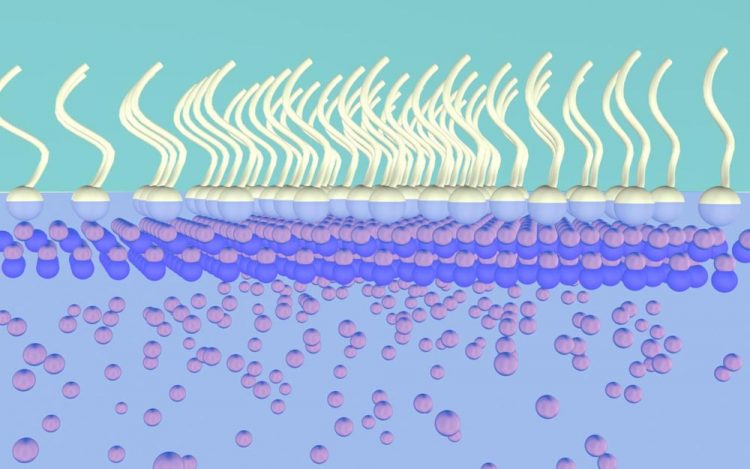Nanosheet growth technique could revolutionize nanomaterial production

The new nanoscale manufacturing process draws zinc to the surface of a liquid, where it forms sheets just a few atoms thick. Credit: Xudong Wang
The group — led by Xudong Wang, a UW-Madison professor of materials science and engineering, and postdoctoral researcher Fei Wang — has developed a technique for creating nearly two-dimensional sheets of compounds that do not naturally form such thin materials. It is the first time such a technique has been successful.
The researchers described their findings in the journal Nature Communications on Jan. 20.
Essentially the microscopic equivalent of a single sheet of paper, a 2-D nanosheet is a material just a few atoms thick. Nanomaterials have unique electronic and chemical properties compared to identically composed materials at larger, conventional scales.
“What's nice with a 2-D nanomaterial is that because it's a sheet, it's much easier for us to manipulate compared to other types of nanomaterials,” says Xudong Wang.
Until now, materials scientists were limited to working with naturally occurring 2-D nanosheets. These natural 2-D structures include graphene, a single layer of graphite, and a limited number of other compounds.
Developing a reliable method to synthesize and manufacture 2-D nanosheets from other materials has been a goal of materials researchers and the nanotechnology industry for years.
In their technique, the UW-Madison team applied a specially formulated surfactant — a detergent-like substance — onto the surface of a liquid containing zinc ions.
Due to its chemical properties, the surfactant assembles itself into a single layer at the surface of the liquid, with negatively charged sulfate ions pointed in the direction of the liquid. Those sulfate ions draw the positively charged zinc ions from within the liquid to the surface, and within a couple hours enough zinc ions are drawn up to form continuous zinc oxide nanosheets only a few atomic layers thick.
Xudong Wang first had the idea for using a surfactant to grow nanosheets during a lecture he was giving in a course on nanotechnology in 2009.
“The course includes a lecture about self-assembly of monolayers,” he says. “Under the correct conditions, a surfactant will self-assemble to form a monolayer. This is a well-known process that I teach in class. So while teaching this, I wondered why we wouldn't be able to reverse this method and use the surfactant monolayer first to grow the crystalline face.”
After five years of trial and error with different surfactant solutions, the idea paid off.
“We are very excited about this,” says Xudong Wang. “This is definitely a new way to fabricate 2-D nanosheets, and it has great potential for different materials and for many different applications.”
Already, the researchers have found that the 2-D zinc oxide nanosheets they've grown are able to function as semiconductor transistors called a p-type, the opposite electronic behavior of naturally occurring zinc oxide. Researchers have for some time attempted to produce zinc oxide with reliable p-type semiconductor properties.
Zinc oxide is a very useful component of electronic materials, and the new nanosheets have potential for use in sensors, transducers and optical devices.
But the zinc oxide nanosheets are only the first of what could be a revolution in 2-D nanomaterials. Already, the UW-Madison team is applying its surfactant method to growing 2-D nanosheets of gold and palladium, and the technique holds promise for growing nanosheets from all sorts of metals that wouldn't form them naturally.
“It brings a lot of new functional material to this 2-D material category,” Wang says.
###
CONTACT: Xudong Wang, 608-890-2667, xudong@engr.wisc.edu
DOWNLOAD IMAGE: https:/
Will Cushman, 608-262-2481, perspective@engr.wisc.edu
Media Contact
All latest news from the category: Materials Sciences
Materials management deals with the research, development, manufacturing and processing of raw and industrial materials. Key aspects here are biological and medical issues, which play an increasingly important role in this field.
innovations-report offers in-depth articles related to the development and application of materials and the structure and properties of new materials.
Newest articles

NASA: Mystery of life’s handedness deepens
The mystery of why life uses molecules with specific orientations has deepened with a NASA-funded discovery that RNA — a key molecule thought to have potentially held the instructions for…

What are the effects of historic lithium mining on water quality?
Study reveals low levels of common contaminants but high levels of other elements in waters associated with an abandoned lithium mine. Lithium ore and mining waste from a historic lithium…

Quantum-inspired design boosts efficiency of heat-to-electricity conversion
Rice engineers take unconventional route to improving thermophotovoltaic systems. Researchers at Rice University have found a new way to improve a key element of thermophotovoltaic (TPV) systems, which convert heat…



